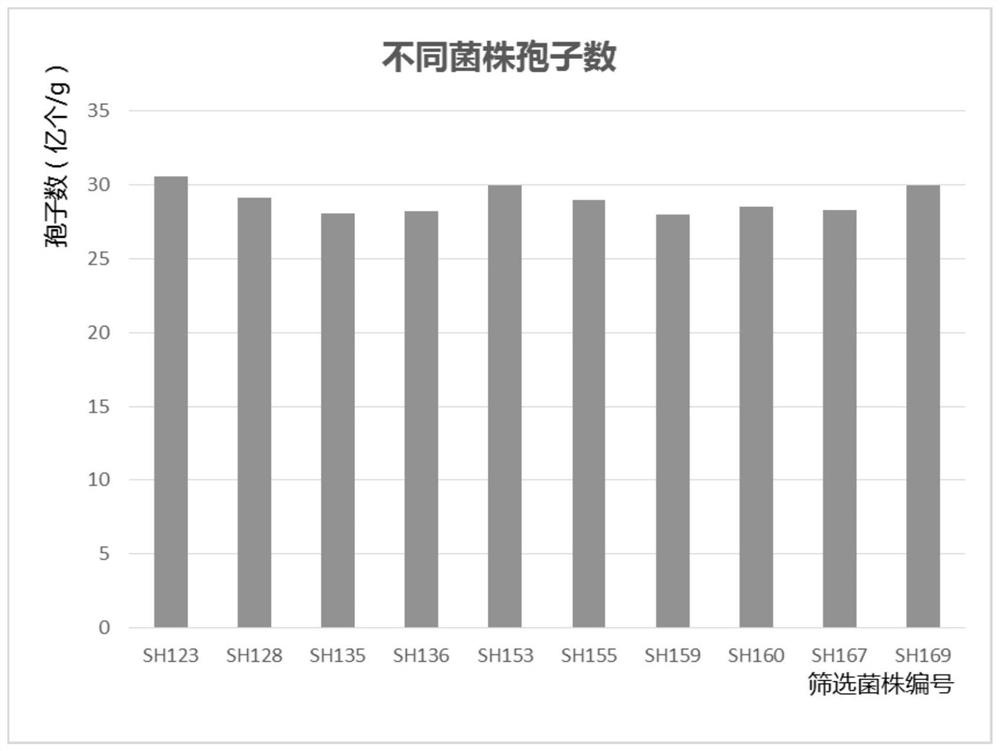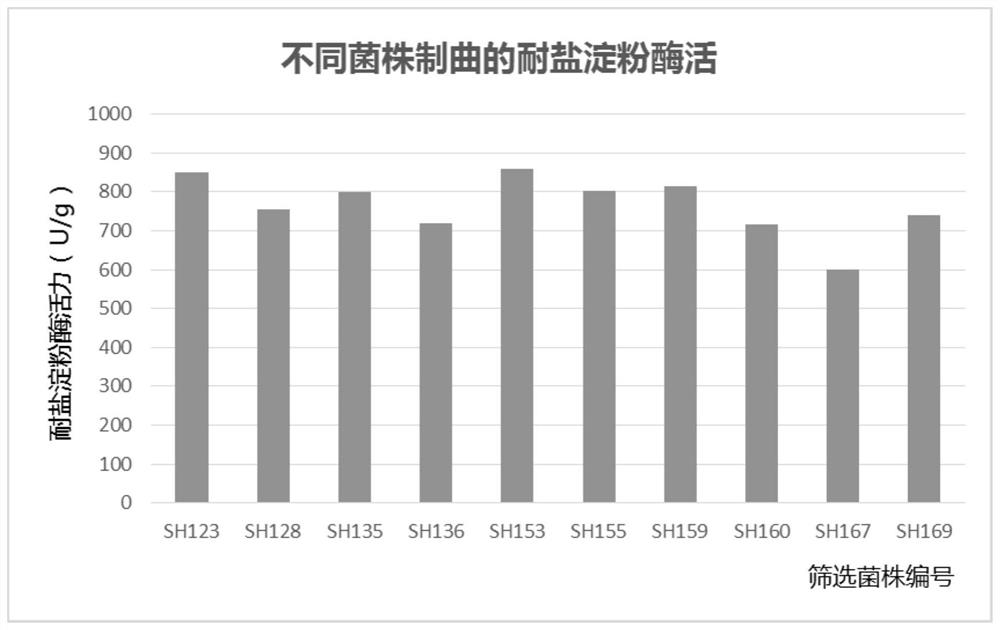Aspergillus oryzae and application thereof
A technology of Aspergillus oryzae and koji, which is applied in the direction of climate change adaptation, fungi, microorganisms, etc., can solve the problems that are not related to the enzyme system index of Aspergillus oryzae salt tolerance, achieve broad application value and prospects, and produce salt-tolerant protease The effect of strong ability and high amino acid content
- Summary
- Abstract
- Description
- Claims
- Application Information
AI Technical Summary
Problems solved by technology
Method used
Image
Examples
Embodiment 1
[0045] Mutation and Screening of Aspergillus oryzae
[0046] Taking Huyao 3.042 as the starting strain, adjust the concentration of Aspergillus oryzae spores to 2*10 6 CFU / mL, the power of the ultraviolet lamp is 20W, after irradiating at 15cm under the ultraviolet lamp for 3min, the spores are centrifuged and washed with sterile saline;
[0047] Gradiently dilute the spore solution after ultraviolet mutagenesis, and spread it on a casein plate containing 10% NaCl, medium composition: casein 4g, KH 2 PO 4 0.36g, Na 2 HPO 4 1.07g, ZnCl 2 0.04g, CaCl 2 0.002g, MgSO 4 0.50g, FeSO 4 0.002g, NaCl 100g, agar 20g, distilled water 1000mL, adjust the pH to 5.5-6.0, and sterilize at 121°C for 15min. After culturing at 30°C for 5 days, the colonies that grew vigorously on the plate and had a large K value were selected and transferred to the re-screening medium. A total of 50 strains were selected according to the K value and named SH121-SH170. Wherein, K value=diameter of...
Embodiment 2
[0051] Soy Sauce Koji Fermentation Pilot Experiment
[0052] Add defatted soybeans and wheat into a 500mL Erlenmeyer flask at a ratio of 1:1, and treat it at 115°C for 15 minutes. After cooling, inoculate the spore powder of the above-mentioned 10 strains at an inoculation ratio of 0.5%, and conduct a small experiment of koji making; After the end, the number of Aspergillus spores, salt-tolerant protease activity, and salt-tolerant amylase activity were detected. The koji was mixed with 23°B'e salt water at a ratio of 1:2, and the fermentation experiment was carried out. After the fermentation, the total nitrogen utilization rate, amino acid nitrogen, and reducing sugar of the fermented crude oil were detected.
[0053] The detection method of aspergillus number refers to "SB / T 10315-1999 Hemocytometer Method" to determine the number of aspergillus species.
[0054] For the detection method of salt-tolerant protease activity, refer to "SB / T 10317-1999 Protease Activity Determ...
Embodiment 3
[0071] Pilot Experiment of Soy Sauce Koji Fermentation
[0072] The SH153 strain obtained from the final screening and the starting strain Huniang 3.042 were used for the pilot soy sauce fermentation experiment.
[0073] The defatted soybeans are pretreated, the pressure is controlled at 0.05-0.15MPa, the temperature is 115-120°C, and the holding time is 8-10 minutes, the wheat is roasted, the pressure is controlled at 0.01-0.05MPa, the temperature is controlled at 300-400°C, and crushed , the particle size is about 80 mesh, and the fried wheat flour is obtained. After the pretreated defatted soybeans and fried wheat flour are mixed at a weight ratio of 1:1, when the temperature drops to 28°C, the screened SH153 and the spore powder of the starting strain Huyao 3.042 are respectively inserted in a proportion of 0.1% for koji making ; Koji making temperature 28-42 ℃, koji making time 36-48h. After making koji, detect the number of koji spores, salt-tolerant protease activity,...
PUM
 Login to View More
Login to View More Abstract
Description
Claims
Application Information
 Login to View More
Login to View More - R&D
- Intellectual Property
- Life Sciences
- Materials
- Tech Scout
- Unparalleled Data Quality
- Higher Quality Content
- 60% Fewer Hallucinations
Browse by: Latest US Patents, China's latest patents, Technical Efficacy Thesaurus, Application Domain, Technology Topic, Popular Technical Reports.
© 2025 PatSnap. All rights reserved.Legal|Privacy policy|Modern Slavery Act Transparency Statement|Sitemap|About US| Contact US: help@patsnap.com



